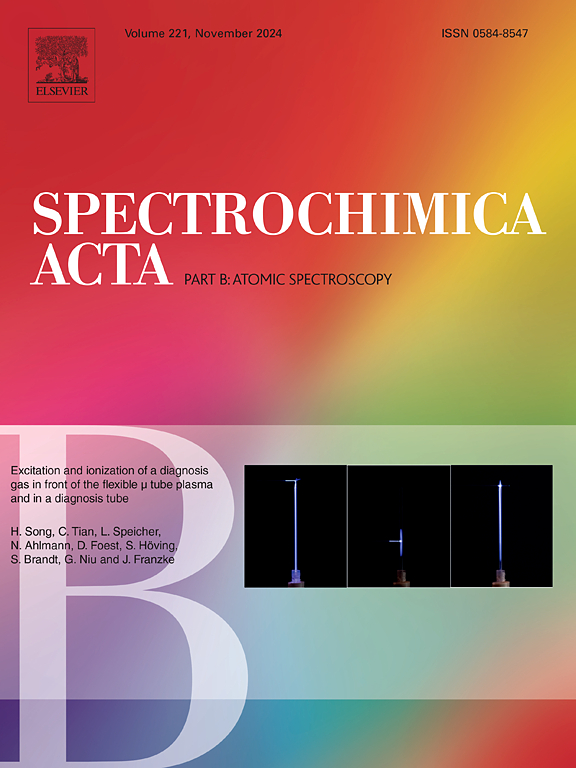Barium isotopic analysis of geological reference materials by MC-ICP-MS
IF 3.2
2区 化学
Q1 SPECTROSCOPY
引用次数: 0
Abstract
Barium (Ba) isotopes have been developed as a valuable tracer for chemical weathering, marine biogeochemical processes, and riverine Ba input to the ocean. To facilitate inter-laboratory data comparisons, it is essential to measure Ba isotope ratios of widely available reference materials. We presented 21 geological reference materials, most of which are new stream sediment Ba isotope reference materials in this study. Purification of synthetic solutions and rock samples with different Ba concentrations and matrix compositions, showed similar elution curves with recoveries close to 100 %. The long-term reproducibility for δ138/134Ba measurements was ≤0.07 ‰ (2SD). The results indicated that the Ba isotope ratios of AGV-2, BCR-2, BHVO-2, GSP-2, RGM-2, GSS-2, GSR-1, GSR-2 and GSR-5 were in good agreement within analytical uncertainties with previously published data. The δ138/134Ba values of sediment materials ranged from −0.31 ± 0.06 ‰ to 0.03 ± 0.07 ‰.With the exception of one stream sediment from a carbonate tributary, all analyzed sediment reference materials exhibited significant homogeneity in Ba isotopic composition, with an average δ138/134Ba of 0.01 ± 0.06 ‰, which was in excellent agreement with the upper continental crust (0.00 ± 0.05 ‰) and the bulk silicate earth (0.07 ± 0.08 ‰). This dataset of reference materials in this study provides the basis for data quality assurance and later inter-laboratory comparison of Ba isotope analyses.

MC-ICP-MS分析地质标准物质钡同位素
钡(Ba)同位素已成为化学风化、海洋生物地球化学过程和河流Ba输入海洋的有价值的示踪剂。为了便于实验室间的数据比较,有必要测量广泛可用的参考物质的Ba同位素比率。本文提出了21种地质标准物质,其中大部分为新的水系沉积物Ba同位素标准物质。不同Ba浓度和基质组成的合成溶液和岩样的提纯曲线相似,回收率接近100%。δ138/134Ba测量值的长期重现性≤0.07‰(2SD)。结果表明,AGV-2、BCR-2、BHVO-2、GSP-2、RGM-2、GSS-2、GSR-1、GSR-2和GSR-5的Ba同位素比值在分析不确定度范围内与前人发表的数据基本一致。沉积物的δ138/134Ba值在- 0.31±0.06‰~ 0.03±0.07‰之间。除1个碳酸盐支流的水系沉积物外,所有样品的δ138/134Ba均具有明显的均一性,δ138/134Ba平均值为0.01±0.06‰,与上陆地壳的δ138/134Ba平均值(0.00±0.05‰)和硅酸盐土的δ138/134Ba平均值(0.07±0.08‰)一致。本研究的标准物质数据集为Ba同位素分析的数据质量保证和后续的实验室间比较提供了基础。
本文章由计算机程序翻译,如有差异,请以英文原文为准。
求助全文
约1分钟内获得全文
求助全文
来源期刊
CiteScore
6.10
自引率
12.10%
发文量
173
审稿时长
81 days
期刊介绍:
Spectrochimica Acta Part B: Atomic Spectroscopy, is intended for the rapid publication of both original work and reviews in the following fields:
Atomic Emission (AES), Atomic Absorption (AAS) and Atomic Fluorescence (AFS) spectroscopy;
Mass Spectrometry (MS) for inorganic analysis covering Spark Source (SS-MS), Inductively Coupled Plasma (ICP-MS), Glow Discharge (GD-MS), and Secondary Ion Mass Spectrometry (SIMS).
Laser induced atomic spectroscopy for inorganic analysis, including non-linear optical laser spectroscopy, covering Laser Enhanced Ionization (LEI), Laser Induced Fluorescence (LIF), Resonance Ionization Spectroscopy (RIS) and Resonance Ionization Mass Spectrometry (RIMS); Laser Induced Breakdown Spectroscopy (LIBS); Cavity Ringdown Spectroscopy (CRDS), Laser Ablation Inductively Coupled Plasma Atomic Emission Spectroscopy (LA-ICP-AES) and Laser Ablation Inductively Coupled Plasma Mass Spectrometry (LA-ICP-MS).
X-ray spectrometry, X-ray Optics and Microanalysis, including X-ray fluorescence spectrometry (XRF) and related techniques, in particular Total-reflection X-ray Fluorescence Spectrometry (TXRF), and Synchrotron Radiation-excited Total reflection XRF (SR-TXRF).
Manuscripts dealing with (i) fundamentals, (ii) methodology development, (iii)instrumentation, and (iv) applications, can be submitted for publication.

 求助内容:
求助内容: 应助结果提醒方式:
应助结果提醒方式:


